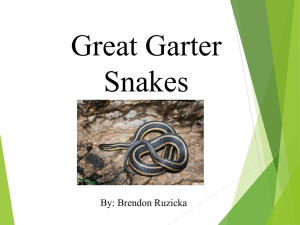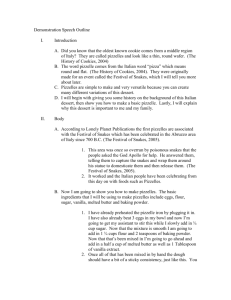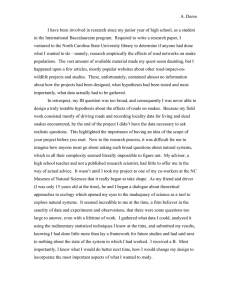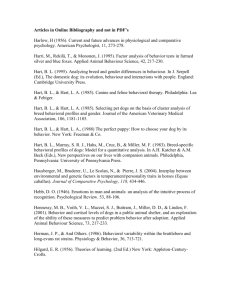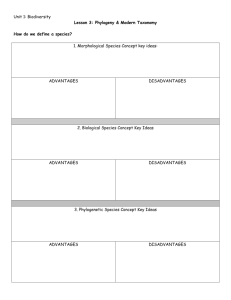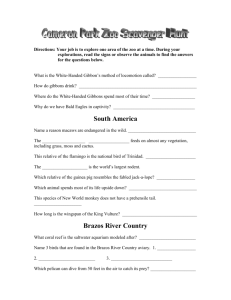Observations of size variation in trematodes infecting red-sided garter snakes ( Abstract Introduction
advertisement
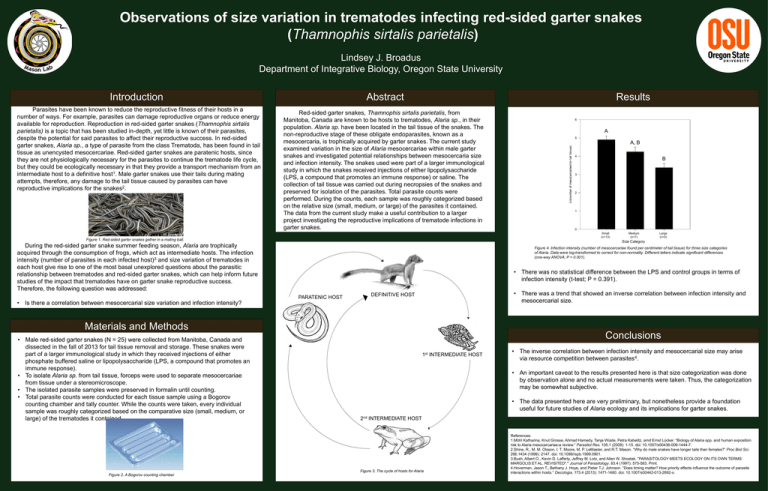
Observations of size variation in trematodes infecting red-sided garter snakes (Thamnophis sirtalis parietalis) Lindsey J. Broadus Department of Integrative Biology, Oregon State University Parasites have been known to reduce the reproductive fitness of their hosts in a number of ways. For example, parasites can damage reproductive organs or reduce energy available for reproduction. Reproduction in red-sided garter snakes (Thamnophis sirtalis parietalis) is a topic that has been studied in-depth, yet little is known of their parasites, despite the potential for said parasites to affect their reproductive success. In red-sided garter snakes, Alaria sp., a type of parasite from the class Trematoda, has been found in tail tissue as unencysted mesocercariae. Red-sided garter snakes are paratenic hosts, since they are not physiologically necessary for the parasites to continue the trematode life cycle, but they could be ecologically necessary in that they provide a transport mechanism from an intermediate host to a definitive host1. Male garter snakes use their tails during mating attempts, therefore, any damage to the tail tissue caused by parasites can have reproductive implications for the snakes2. Abstract Results Red-sided garter snakes, Thamnophis sirtalis parietalis, from Manitoba, Canada are known to be hosts to trematodes, Alaria sp., in their population. Alaria sp. have been located in the tail tissue of the snakes. The non-reproductive stage of these obligate endoparasites, known as a mesocercaria, is trophically acquired by garter snakes. The current study examined variation in the size of Alaria mesocercariae within male garter snakes and investigated potential relationships between mesocercaria size and infection intensity. The snakes used were part of a larger immunological study in which the snakes received injections of either lipopolysaccharide (LPS, a compound that promotes an immune response) or saline. The collection of tail tissue was carried out during necropsies of the snakes and preserved for isolation of the parasites. Total parasite counts were performed. During the counts, each sample was roughly categorized based on the relative size (small, medium, or large) of the parasites it contained. The data from the current study make a useful contribution to a larger project investigating the reproductive implications of trematode infections in garter snakes. A, B 4 B 3 2 1 0 Medium medium (n=7) Large large (n=5) Figure 4. Infection intensity (number of mesocercariae found per centimeter of tail tissue) for three size categories of Alaria. Data were log-transformed to correct for non-normality. Different letters indicate significant differences (one-way ANOVA; P = 0.001). • There was no statistical difference between the LPS and control groups in terms of infection intensity (t-test; P = 0.391). PARATENIC HOST • There was a trend that showed an inverse correlation between infection intensity and mesocercarial size. DEFINITIVE HOST Materials and Methods Conclusions 1st INTERMEDIATE HOST • The inverse correlation between infection intensity and mesocercarial size may arise via resource competition between parasites4. • An important caveat to the results presented here is that size categorization was done by observation alone and no actual measurements were taken. Thus, the categorization may be somewhat subjective. • The data presented here are very preliminary, but nonetheless provide a foundation useful for future studies of Alaria ecology and its implications for garter snakes. 2nd INTERMEDIATE HOST Figure 3. The cycle of hosts for Alaria Figure 2. A Bogorov counting chamber 5 Size Category During the red-sided garter snake summer feeding season, Alaria are trophically acquired through the consumption of frogs, which act as intermediate hosts. The infection intensity (number of parasites in each infected host)3 and size variation of trematodes in each host give rise to one of the most basal unexplored questions about the parasitic relationship between trematodes and red-sided garter snakes, which can help inform future studies of the impact that trematodes have on garter snake reproductive success. Therefore, the following question was addressed: • Male red-sided garter snakes (N = 25) were collected from Manitoba, Canada and dissected in the fall of 2013 for tail tissue removal and storage. These snakes were part of a larger immunological study in which they received injections of either phosphate buffered saline or lipopolysaccharide (LPS, a compound that promotes an immune response). • To isolate Alaria sp. from tail tissue, forceps were used to separate mesocercariae from tissue under a stereomicroscope. • The isolated parasite samples were preserved in formalin until counting. • Total parasite counts were conducted for each tissue sample using a Bogorov counting chamber and tally counter. While the counts were taken, every individual sample was roughly categorized based on the comparative size (small, medium, or large) of the trematodes it contained. A Small small (n=13) © Friesen Figure 1. Red-sided garter snakes gather in a mating ball. • Is there a correlation between mesocercarial size variation and infection intensity? 6 Ln(number of mesocercariae/cm tail tissue) Introduction References: 1.Möhl Katharina, Knut Grosse, Ahmad Hamedy, Tanja Wüste, Petra Kabelitz, amd Ernst Lücker. “Biology of Alaria spp. and human exposition risk to Alaria mesocercariae-a review.” Parasitol Res. 105.1 (2009): 1-15. doi: 10.1007/s00436-009-1444-7. 2.Shine, R., M. M. Olsson, I. T. Moore, M. P. LeMaster, and R.T. Mason. “Why do male snakes have longer tails than females?” Proc Biol Sci. 266.1434 (1999): 2147. doi: 10.1098/rspb.1999.0901. 3.Bush, Albert O., Kevin D. Lafferty, Jeffrey M. Lotz, and Allen W. Shostak. "PARASITOLOGY MEETS ECOLOGY ON ITS OWN TERMS: MARGOLIS ET AL. REVISITED*." Journal of Parasitology. 83.4 (1997): 575-583. Print. 4.Hoverman, Jason T., Bethany J. Hoye, and Pieter T.J. Johnson. “Does timing matter? How priority effects influence the outcome of parasite interactions within hosts.” Oecologia. 173.4 (2013): 1471-1480. doi: 10.1007/s00442-013-2692-x.
